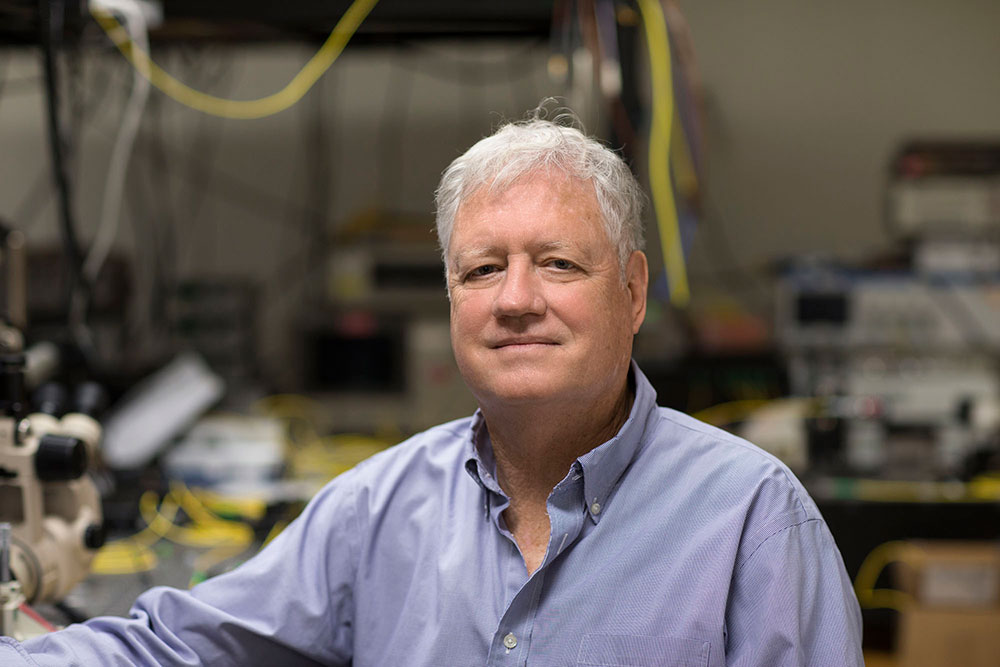When one thinks of influential Campbells, the mind usually turns to a certain soup-making family. Many people outside the world of engineering may not know the University of Virginia’s Joe C. Campbell, but chances are that they use his inventions much more often than they heat up a bowl of chicken noodle.
The work of Campbell, Lucien Carr III Professor of Electrical and Computer Engineering, directly affects the speed at which phone calls, text messages, streaming videos and nearly every other major form of communication are sent.
He joined the Engineering School faculty in 2006 and was recently named a fellow in the National Academy of Inventors in recognition of his contributions to the field of telecommunications and fiber optics. Fellowships are awarded to academic inventors who embody the spirit of innovation and whose inventions have made a tangible impact on human welfare and economic development.
“Most of the recognition I’ve received is for my work with avalanche photodiodes,” Campbell said.
Avalanche photodiodes are semiconductor photo-detectors that are used in long-distance fiber-optic communications, where information is transmitted as pulses of light.
“In a fiber-optic link, the information is usually transmitted digitally, where a light pulse is a ‘one’ and no light pulse is a ‘zero,’” said Campbell. “So the information is transmitted with pulses of light down hair-thin glass fibers and at the other end, you have to convert that back into an electrical signal, and that’s what my device does.”
For example, if you text a photo to a friend, it gets broken down into a binary code of light pulses and then Campbell’s avalanche photodiode reassembles it into an image right before it’s delivered.
He first began developing the device in the 1970s while he was working at AT&T Bell Laboratories and has continued to update it ever since.
“He does an amazing job identifying a problem and pursuing it with laser focus. Joe is without a doubt the world leader in these types of photo-detectors,” said John Lach, who chairs the Department of Electrical and Computer Engineering.
Campbell’s latest research on Grounds is focused on how to greatly increase the speed and capacity of his detectors.
“As of the past few months, we have a new breakthrough that we think will really transform fiber optics and data communications. It’s a new type of photodiode,” he said.
The new device is similar to the avalanche detector, but it’s made from new material and has a new structure that allows it to work at much higher speed.
“To give you an idea, the standard for many years for most links has been a 10-gigabit-per-second transmission speed,” he said. “Your eye communicates with your brain at about 1 gigabit per second.”
Telecommunications companies have been under pressure to move up to 100 gigabits per second, and many would like to go even higher than that to handle the growing number of users and devices on their channels.
“Their goal is to go beyond that to 400 gigabit, but the detectors they need to do that don’t exist yet,” Campbell said.
He and his team at UVA are about to change that.
“We think the new detectors we’ve been working on will be able to handle that speed and 400-gigabit Ethernet capability is going to be a big deal,” he said.
In addition to supporting faster Internet and phone communications all over the world, Campbell’s body of work also includes new technology that’s assisting the Department of Defense. He’s been working with the U.S. Army to adapt his avalanche photodiodes so their light detection capabilities can be used to identify biological agents.
“Basically, the Army has a box that sucks in air and they have either a laser- or light-emitting diode that excites fluorescence from the biological material,” Campbell said. “Then our detectors measure different wavelengths of the fluorescence, and by taking the ratio of those wavelengths, the materials inside the box can be classified.”
In the past, Campbell has also worked with the military on creating better night vision binoculars and more efficient long-range communication using microwave signals.
Despite the commercial success of his inventions, it’s a pure love of discovery that drives Campbell to keep innovating and he’s always excited to pass that on to fellow engineers.
“Joe is just an outstanding citizen in our department,” Lach said. “He goes out of his way to support the initiatives of younger faculty and he scours the earth to find the best possible graduate students and encourage them to come here. Once they’re here, he always takes a genuine interest in their success.”
At the end of the day, Campbell is just glad to be able to continue sharing his passion for innovation with others.
“I got a Ph.D. so that I could do basic research. When I was at Bell Laboratories, I just loved playing in the lab,” he said. “Now I do most of my research together with students and it’s been so rewarding to watch those same students mature and become my peers.”
Media Contact
Article Information
December 18, 2015
/content/inventive-uva-professor-boosts-communications-around-globe

